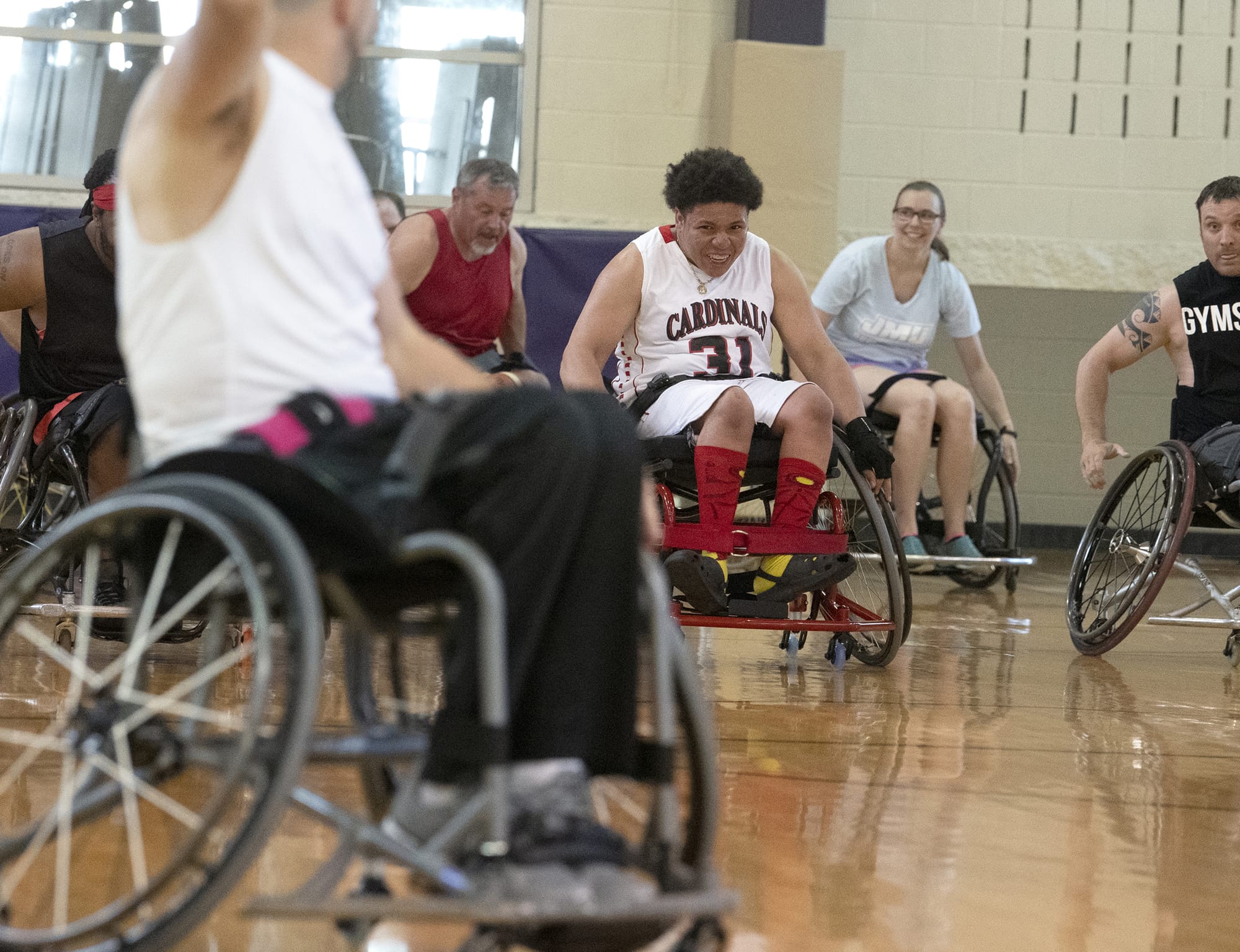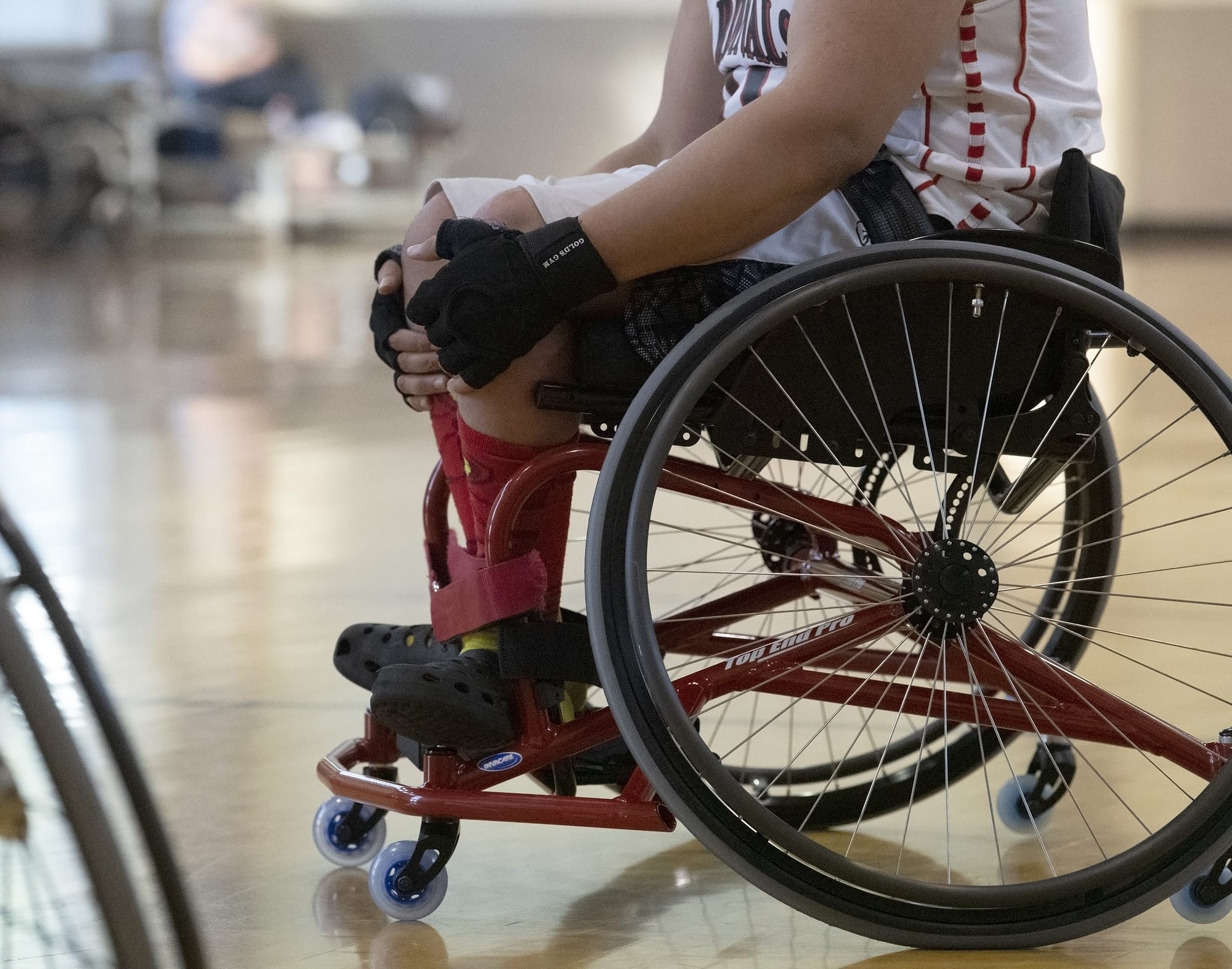
Story and photos by Mike Tripp, contributor
Growing up in the Dominican Republic, Anderson Ramos Rodriguez was yet another NBA fan who idolized LeBron James and dreamed of playing basketball himself.
“I’ve wanted to play my whole life,” says Rodriguez, now 18. “That’s what I love.”
Cerebral palsy complicated that ambition but didn’t keep him from trying, recalls his mother, Paula Rodriguez.
“He would lay on the ground still, trying to play,” she says.
In 2015, she and her son left the Dominican Republic behind to join Anderson Rodriguez’s grandmother in Harrisonburg. One day last year, they met a man in Ralph Sampson Park who tipped them off to an exciting possibility.
“He said that there was a basketball team here,” Rodriguez recalls. “A wheelchair basketball team.”

Anderson Ramos Rodriguez arrives at the Lucy Simms Center for the Harrisonburg Cardinals’ weekly practice.
Inspired, Rodriguez stopped in to see David Shenk, a home-school liaison at Harrisonburg High School.
He cut right to the chase: “I’m really passionate about basketball. I’ve heard there’s a wheelchair basketball team here, and I want to play,” he told Shenk.
That conversation led to Rodriguez joining the Harrisonburg Cardinals — a team that competes in the National Wheelchair Basketball Association, practicing every Thursday at the Lucy F. Simms Center.
For the first few months, Rodriguez borrowed an athletic wheelchair from the coach, Tim Moubray.
Today, however, he arrives with a brand new one of his own, bright red. Some teammates and others pitch in to get it ready for first action.
One of Rodriguez’s teammates had suggested he look into a grant from the Challenged Athletes Foundation. Back at school, Shenk helped him fill out the application.
“The grant approved $1,980 for a chair, which ended up covering everything,” he said.

With his mother behind him, Anderson Ramos Rodriguez watches as teammate James Carter, home-school liaison David Shenk and Joyce Carter attach the wheels to Rodriguez’s new athletic wheelchair.

By the time practice starts, Rodriguez is ready to roll. Although quick to join the action, the young athlete felt a bit of trepidation those first few times.
“Everybody else on the team is a lot older than I am,” he says.
Two years earlier, the Cardinals made it to the national championship, losing by only a couple points. Still, the team was eager to welcome a newcomer.
“The first Thursday I was super nervous,” Rodriguez says. “That was the first time I’d ever set foot onto a basketball court.”
“I felt like I was at home, because I saw these people in wheelchairs like me and identified with them. I can’t express what I felt at that moment. … It was something precious and special.”


Leaning back in his chair, Rodriguez fires off a bucket. He misses. That’s why there’s practice.
Coach Moubray divides his players into two teams for a series of quick scrimmages.
Unable to contain a grin, Rodriguez powers his chair from one end of the court to the other, again and again.
- Anderson uses the wheel of his chair to help control the ball as he takes possession of it.
- Anderson battles to spin his chair around as the ball passes behind. Teammates joked his new athletic wheelchair would soon have a few scratches and scrapes resulting from normal play of the game.
Players jockey for position and for the ball, their chairs dancing chaotically across the court. Rodriguez’s pristine red chair, they joked at the beginning of practice, would soon earn some battle scars, and now, there it is, in the thick of the action, bumping and colliding with the others.
At the end of the first brief scrimmage, Moubray gives an exhausted Rodriguez a breather.


But soon, he’s ready to go again. Giving his legs a final adjustment, Rodriguez enthusiastically returns to play. Up and back again. Up and down.
- Anderson leans back and fires of a shot for the basket as teammates watch.
- Anderson battles for the rebound.
- Anderson races his chair downcourt among his teammates as action shifts from one end of the court to the other. The fast pace game takes lot of upper body strength to control and move the chair as needed, where needed.
He’s given it his best, but knows this is about the long game. There’s work to do before the season begins in earnest next fall.
“It teaches you that in life, you have to learn, and you can’t give up,” Rodriguez says.
When practice ends, the team circles and congratulates each other on a job well done.
“For me, the team is like my family. … My second family,” Rodriguez says with a smile. “And the court my second home.”

Teammates congratulate Anderson on a strong performance at the end of the Harrisonburg Cardinal’s weekly practice.
Journalism is changing, and that’s why The Citizen is here. We’re independent. We’re local. We pay our contributors, and the money you give goes directly to the reporting. No overhead. No printing costs. Just facts, stories and context. Thanks for your support.



















